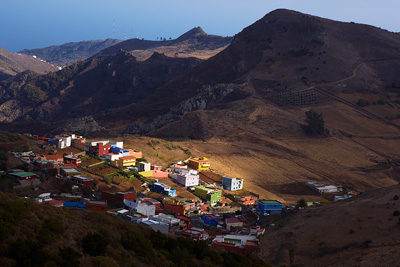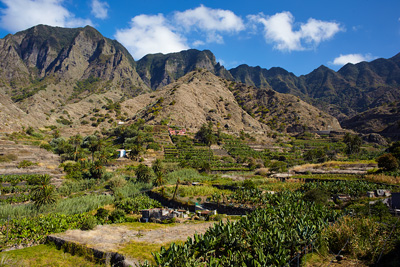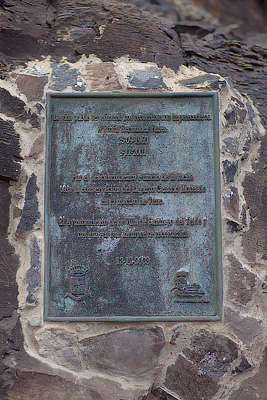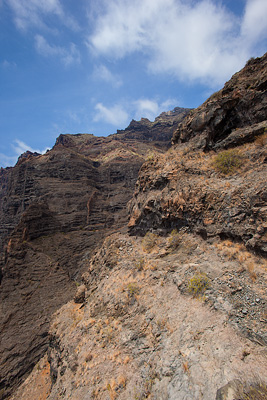field notes
canary islands, 2012
Gallotia stehlini was the first exotic lizard species in my terrarium when I was 14 years old. Then, in 1980-s, I learned about the Canary Islands because of that. Living behind the “Iron Curtain”, I couldn't even dream to ever have an opportunity to go there. Many things changed since then, and I travelled many other places, but the Canaries weren't among them. Because they are in Europe, and I am usually thinking that I will always have time to go to places on the continent where I live, they weren't even in my travel plans for the next future — till my wife insisted that we at last spend a vacation in a more “civilised” place than usually. Then the Canary Islands came again to my mind that were looking like a perfect compromise beween a relaxed vacation and good opportunities for nature photography, particularly for someone like me, interested in herpetological subjects.
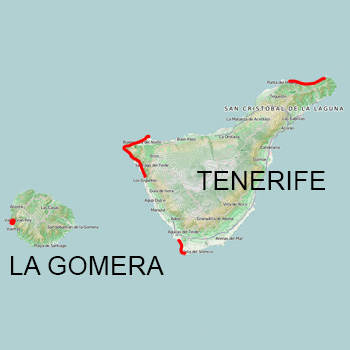
getting there and moving around
Since Canary Islands belong to Spain, finding a flight from anywhere in continental Europe isn't a problem. However, there are few direct flights, and most go over Barcelona or Madrid in Spain. As usually with my trips, airplane tickets were also this time the biggest expense. Although it was an inner European flight, offers of most companies flying from Germany to Tenerife were almost as expensive as some intercontinental flights to Africa, Asia and even North AMérica. The Spanish company Vueling was the cheapest, but probably the worst, airlines flying there. Of course, because it was the cheapest, I took it. When I was sitting in the airplane, I had to think hard if I ever had such an uncomfortable seat. Indeed, there had been only one company else the I flew with whose sets were as bad — African Safari Airlines. No meals on board were included in ticket price. The flight schedule was very inconvenient: A very long waiting for the connection flight was necessary in Barcelona. When calculating the costs and comparing offers, add at least 30€ to the ticket price of Vueling for food and drinks during it. Also note that the flights of Vueling are advertised and sold as Iberia, but they aren't. Now I have an opinion that it is better to fly by KLM or Air France. It will cost a hundred more, but you won't loose so much time and food will be included in the ticket. All flights from Germany going over Barcelona to Tenerife are performed by Vueling. Therefore, if you want also a stop in this city on your way to Tenerife, you have no alternatives. If you book the flight not as Iberia but as Vueling, it will be the lowest price, but most likely you would have to pay for baggage extra. Baggage is included if you book it as Iberia. Making a stop in Barcelona doesn't make any sense if you have your equipment with you. Don't expect to have an opportunity to see the city even if you have much time unless you would carry your hand luggage with you during sightseeing: Neither at the airport at the nearest railway station there are lockers where you could leave you baggage. The main railway station where lockers could be is too far from old centre. Therefore much time is needed first to reach it, to leave the baggage, and to go to the centre from there.
Of course, there were flights from Europe to La Gomera, but their offer is much smaller and prices are higher than to islands with mass tourism. Therefore I preferred to go to Tenerife and from there to La Gomera than the other way around. The same car that was rented on Tenerife can be used also on La Gomera because it can be brought there on a ferry. The way even by the slowest (and the cheapest ferry) — Armas — takes around 1.5 hours. For a return ticket for two persons and a car I paid about 115€.
The best and the only practicable for a photographer transportation means on the Canary Islands is a car. There are very many car rental companies in Tenerife, and finding an offer that meats your requirements shouldn't be a problem at all. Usually I don't book a car in advance because in many other countries it costs less when you choose a car rental agency and the car upon arrival. With the Canary Islands, I discovered that it costs the same or is even cheaper to book the car online from home. The offers of Canarian or Spanish rental companies are normally cheaper than of the international. However, they have offices not at all airports. Nevertheless, it may be possible to book a service already starting from your arrival airport. In that case they will pick you up with their own minibus and bring you to their office in the city. If you are in a hurry or prefer an international car rental company for some reason, you can find offices of Hertz, Avis and Europcar at any airport on the Canaries.
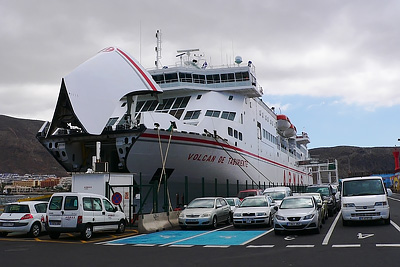
Cars waiting for bording of a ferry to La Gomera. The light grey Seat standing on the line 3 is mine. (Click on picture to enlarge.)
The longer the rental period the lower is the rate per day. Of course, it also depends on the type of the car you want to get. The cheapest are the smallest cars, such as Fiat Punto or Renault Clio. I chose a little higher class — Seat Ibiza. When I was travelling, they charged around 22€ per day for it. The price announced in advertising isn't normally the one that you will pay because it may not include all insurances that you finally will have to agree with. On the Canary Islands they have a mandatory insurance against car damage for every island, i.e. if you go to more than one with the car, it will cost additionally. The rental company will also request you to purchase an extended insurance claiming that it would be covering absolutely all damages on the car. This is insurance isn't very expensive but nevertheless you can safe also this money if you have a travel insurance that covers also physical damage of a rented car. My insurance was most probably including this but I preferred to pay also the offered one because I expected everything to be easier to settle in case of car damage.
The return of the car was a funny act. I was flying back from Tenerife South — a different airport than of arrival. So the car had to be returned to a different office. When I arrived at the airport, the office was already closed. Therefore they just ask me to leave the car on their parking lot and to throw the key through the window of the desk.
To drive a car on the Canary Islands was also very easy. On La Gomera the roads were quite empty most of the time. Many roads were narrow but much easier to pass than in other countries where I was already driving a car in the mountains. Since not very many tourists visit La Gomera, hired cars weren't common. On Tenerife there were much more cars, but the traffic wasn't very intensive, and jams didn't occur.
Fuel was a little cheaper than in Germany, and the Seat Ibiza that I was driving was consuming very little of it: In two weeks of daily driving in the mountains and around the islands I spent only 80€ for petrol.
Orientation was also very easy: The Canary Islands were covered by Garmin City Navigator maps that were installed in my Garmin GPS navigation. Of course, there were many good paper maps of the islands.
For best comfort, some knowledge of Spanish should be recommended. Although most foreign tourists come from Germany, UK and Russia, and don't speak a word Spanish, local people, even those who work in hotels or are state officials, normally have extremely limited command of English, or any other foreign language. I discovered that not even medical personnel adequately speaks a foreign language. This surprised me a lot because I had expected that at least someone who finished a high school should have at least a basic knowledge of it.
accommodation and food
There is no such thing as wilderness on the Canary Islands. From any nature site hotels and beaches can be reached by car in not more than half an hour. You can drive around the largest island — Tenerife — in less than one day. There are no wild places on the coast of Tenerife except on steep rocks because all areas that are more or less flat are almost entirely occupied by settlements and beaches.
Inside the island there is a very good network of roads that allow very quick crossing of any part of the island from the north to the south. Hence, even if you stay not directly at the coast, you can reach it usually in not more than an hour.
La Gomera is about 7 times smaller than Tenerife and completely covered by mountains, with gorges and narrow valleys. It has no such wide beaches with sand as the larger islands among the Canaries, and thus doesn't attract as many leisure tourists. Many tourists come from Los Cristianos on Tenerife to La Gomera for short one-day visit. People who spend more than one day on this island are those who like nature and hiking rather than lying on a beach. Also La Gomera is a popular destination for people seeking remoteness and quietness of small towns and villages at ocean coast instead of crowds and noise of large hotel resorts.
Staying in a tent was prohibited everywhere on Tenerife and La Gomera except a couple of camping sites I have read about but nowhere seen myself. Therefore, bringing a tent and camping stuff shouldn't be a good idea. For someone who nonetheless wants to sleep outside, it should be possible just to do it anywhere in a quiet place without tent. This is probably not allowed, too, but it is unlikely that someone who discovers you would immediately call police. On La Gomera I have seen many people looking like vagabonds who, I'am assuming, slept just outdoors without any shelter.
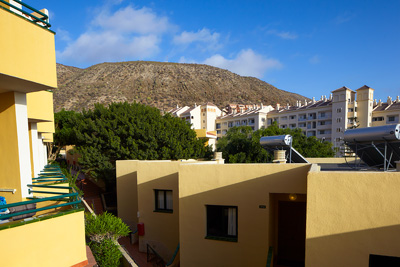
A view at Montaña de Guaza (Guaza Mountain) from the balcony of my apartment in Los Cristianos. The second known population of Tenerife Speckled Lizard (Gallotia intermedia) that lives on this mountain was the reason for me to chose this hotel. (Click on picture to enlarge.)
Holiday apartments are the most usual accommodation on the Canary Islands. Such an apartment has usually two rooms — one bedroom and one larger, with a kitchen — and is large enough for 2 or even 4 persons. During my visit the lowest prices were between 23€ and 50€ per day. Of course, if you are alone, you'd pay this price too, but it is not really much, compared to many other countries, for such a high-quality stay. Of course, apartments in houses that are far from the coast should be even cheaper. Accommodation on La Gomera is cheaper than on Tenerife. Everywhere on the Canary Islands prices also depend on season. In September, it was still a holiday season, therefore the prices were higher. Also there was a price difference between privately offered apartments or bungalows (called “finca”) and those that are run by large companies. Such hotel resorts are particularly large on the south coast of Tenerife — in Los Cristianos, Playa de Las Américas and some other places of mass tourism. My base during the first week of this trip was in Puerto de la Cruz at the north coast of Tenerife where I paid 235€ for an apartment in a beautiful house near the Botanical Garden and in a few minutes of walk from the coast, i.e. around 33 euros per day. The last 3 days of the trip I spent in Los Cristianos where I stayed in a large tourist resort “Oasis Mango”, with a view at the Guaza Mountain where I attempted to find Gallotia intermedia. I paid 69€ for this apartment, i.e. only 23 euros per day.
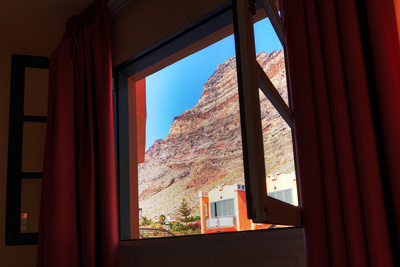
View at La Mérica rock (Risco de La Mérica) through a window of my hotel room — the terra typica of Gallotia bravoana and the stronghold of the last population of this species. (Click on picture to enlarge.)
On La Gomera hotels are smaller but there are also at least three mass tourism hotspots — Valle Gran Rey and La Calera, Playa de Santiago, Santa Catalina — where accommodation may be a little more expensive than in small villages inside the island. Since I was planning attempts to photograph Gallotia bravoana I went to Valle Gran Rey and got an apartment in small apartment hotel just in front of the rock with the last population of this species. For 5 days of stay there I paid 130€, i.e. 26€ per day.
All large apartment houses have wireless Internet hotspots. However, their range was limited to the area around the reception desk. Therefore, you need to sit there with your smartphone or portable computer. Usually the use of Internet had to be paid extra, but in some places, such as the apartment hotel Las Tres Palmeras where I stayed on La Gomera it was free of charge. Of course, mobile phone network was gapless on the entire territory of the Canary Islands. For an owner of a mobile phone contract in a EU country roaming was not very expensive.
Normally no meals are included with the rent of an apartment, and you have either to buy food and to cook yourself, or to eat in a restaurant. During this trip, I did both. However, I didn't go to restaurants too often: Since I don't do it when I am at home — where I have a kitchen — why should it be different in a place where I had a kitchen, too? The prices in restaurants were somewhat lower than in my home city. Certainly, fish and seafood were cheaper on the Cananries than in my home country. Therefore, when I was in a restaurant, I always ordered fish or seafood. Usually I paid around 15-20€ for a meal and a glass of wine for on person. In Germany for a similar meal I would have paid around 20-30% more.
The prices in supermarkets were comparable with those on the continent. Of course, the offer was different than in Central Europe. For instance, there were more and better fruits and vegetables but less fresh meat and cheese. Also I was glad that traditional Spanish air-dried ham, excellent wine and port were cheaper than in my country. The easiest meal for self-preparing was paella because all necessary ingredients were available in every super market.
Water appears to be a problem on these islands — not because of its general shortage but because of difficult access to drinking water when you are in the field. Generally people were supposed to buy bottled water. Although it costs money, this circumstance could be okay in places with shops or restaurants, but may turn dangerous for someone who happened to get stuck in a remote place with an empty water bottle. Largely because of it, I nearly had a deadly accident that I described in the grey box below. When you go to a place where you've never been before it is very difficult to estimate how long will it take and what to expect there. Even if you need less than half an hour to go 2km on a road, you may need two hours for the same distance in the mountains. Unlike in many other regions of the world you shouldn't rely on availability of sources of drinking water when you are going to hike in the mountains on the Canary Islands — at least not in hot and dry months — and take a good reserves of water with you. However, a photographer who has to climb the cliffs under burning sun with 10-15kg of gear in the backpack simply can't carry endless amount of water and food in addition to it. Therefore, I took with me about 1.5l water — an amount that appeared to me reasonable for a 3 hours walk that I was planning. Also I was thinking that there will be water in streams that I saw on the map and that were running in narrow gorges to the ocean coast. Both proved to be a mistake: The walk took more than 5 hours, and the streams were dried out, and the water in my bottles was finished even before I could take the way back.
my rescue from the los gigantes cliffs
I started my way from a small parking lot at the houses of "Club II" — a block of noble villas situated at the northern end of the town and at the beginning of first rock of Los Gigantes. On a very narrow path, I went along two of the rocks, all the time with heavy equipment on my back. The walk in one direction was a fun, but took about two hours because I couldn't go quickly. The path was slippery and barely visible; the slope was very steep — almost vertical; the water of the ocean was far below. So I had to be careful and to watch my steps. However, the sun was at the other side of the mountain, it wasn't hot for at least the first hour, and I wasn't tired. Unfortunately, no lizards were around, and I continued walking.Things went wrong on my way back. The sun was burning the slope already, and I drank the last drops of water and ate my lunch when I was in the gorge. I went back when it was already very hot, and I realised that searching for gallotias doesn't make sense. I was very tired, and gallotias, even if there were any, had escaped the sun. Therefore I accepted the result that I had, i.e. photographs of the young, and started my way back, to the parking lot where my wife was waiting. She refused to go with me when she saw the path and the cliffs. As always, I had my topographic GPS device that was recording the way there and should make it easier for me to find the way back. Only one path existed on those rocks that had been probably made by herpetologists researching the lizards — I can't imagine someone else want to go there. Sometimes this path was interrupted by large stones or debris that I had to cross without seeing the path. However, I was finding it again.
Although I was using a GPS navigation, I lost the path on my way back a couple of times. To find it again, I had to climb the slope down and up several times. Therefore I was losing time and energy. Often I hat to move literally as a climber — grabbing small bulges in the rocks with my fingers. I had no water and the sun was burning.
Suddenly I felt prickling in my face. It was like that feeling in a leg after you have been sitting on it. Soon I got this feeling in my hands, arms, legs. I had to sit down because I couldn't go anymore, and my hands stopped responding to my brain — the fingers were frozen in a curved position and not moving. I still could move my arms a little, and I pulled the mobile phone out of my bag by squeezing it between my hands. By hitting the knobs with a hand, I even managed to dial the number of my wife's phone and called her. She could hardly understand me because my tongue was frozen, too, and obeying me: What was coming out were sounds, not words. This condition was rapidly getting worse, and soon I was almost paralysed. I was lying on a steep hang under burning sun. I could not move and wasn't even trying because I was afraid to fall down the rock.
My wife called 112 — the standard emergency number in Europe — but they didn't understand her because their staff wasn't speaking any other language than Spanish. My wife doesn't speak Spanish at all. Her call was transfered between several people till there was someone who was speaking German. However, they weren't able to understand what was happening. After that she called me and told that I should try to call 112 in order to explain them and to give my position. When I called, they again were speaking neither German nor English, and my Spanish was very limited, particularly in these circumstances. They again passed my call to a woman who were speaking German more or less, so that I could explain her my problem. She told me only that I should stay where I was because I probably had thermal shock — that I should breeze deeply. I was trying to explain her that I was lying on a rock right in the sun unable to move even if I would want too. I felt that she wasn't understanding me. I tried to tell her my position but she weren't able to record it, too. Then she ask me to wait, and they will call me back.
An hour passed since the appearance of the symptoms, and I was still lying in the sun without movement. Nobody was calling. I was watching tourist boats passing my rock — small white spots on bride blue water, far far below... Now and then I was shouting to them for help, but no one was noticing me. Of course, I was in panic and thinking that I would never live this place alive.
Finally, my phone rang. Someone on the other end of the line was asking in Spanish and bad English the same questions again about the situation. Then this person transferred the call to a man who was sounding like their boss. His English was much better and he was able to write down the coordinates of my position that I was dictating. Then she told me that he was sending help to me. It was after more than an hour had passed since the beginning of this accident. I suddenly noticed that I was already talking normally and could better control my hands. I even could move my legs almost normally.
Soon my wife called and told that an ambulance arrived, but she wasn't able to talk with them because they all were speaking only Spanish. She only understood that a helicopter was going to come. When I heard the word “helicopter”, I was horrified: It were enough if someone had come to me on the same path, brought me some water and helped me to find the way back. Why a helicopter?! I asked her to give one of the man from the ambulance the phone and tried to explain that I would rather try to get out of this trouble myself than to wait for a helicopter. The weren't understanding me!
Then I stood up and climbed up the slope to the path where it should be according to GPS. I found it and didn't lose anymore till in 20 minutes I came to the place where I left my wife and my car 5 hours before. When I arrived, I saw not only an ambulance but also 2 cars of rescuers. I appeared right at the moment when the rescuers were putting on their equipment and getting instructions from their commander: They were going to start a rescue operation — two and a half hours after I called them and told that I was almost paralysed.
Of course, the rescuers were surprised to see me, but since none among them could speak English or German, and I couldn't speak Spanish, no questions followed. In the ambulance, they only measured blood pressure — and did nothing else. The diastolic pressure was very high. They offered me to go with them to a hospital, but I rejected because I was feeling not so bad anymore. I was only thirsty and hungry. I could even drive the car, and my wife and I took it and went to a restaurant.
Now my wife is saying that I obviously was ready to pay any price for a photograph of a Gallotia intermedia, and almost did pay — with my life. I have drawn three conclusions from this incident for myself: Don't underestimate the heat and the lack of water on the rocks on the Canary Islands — always take enough water and food with you; although it is Europe, too, the Spanish rescuers aren't like German, hence don't expect them to be there when you would need it; don't expect even those professionals who should be able to work with foreigners to speak any language except Spanish.
photographing the lizards
The wildlife of the Canary Islands is scarce. No endemic mammals live there except bats. The largest mammals are introduced rabbits and domestic goats who now live free in the mountains. There are some interesting endemic species of birds, including the famous Atlantic Canary (Serinus canaria), the ancestor of the domestic Canary bird, which is very common. More exotic looking birds, such as parrots, either escaped from captivity or came from nearby Africa, and live also free on these islands. The proximity of Africa also explains the relative richness of the invertebrate fauna of the Canaries.
The focus of my interest and photography efforts was this time on Canarian herpetofauna which is pretty unique. All native species of reptiles are endemics of the islands. Amphibians were originally absent there, but now populations Stripeless Tree Frog (Hyla meridionalis) exist on all 7 islands of the archipelago. This species is widely spread on the European continent and was introduced to the Canaries in the recent history. Native species of snakes and turtles are also absent. Unfortunately an allian species of snake is found on Gran Canaria — Californian King Snake (Lampropeltis getula) — that now threatens the endemic fauna, particularly the lizards.
Certainly, lizards are the most exciting and unique group of vertebrates on the Canary Islands. Around 16 species of them are currently recognised there, and all are endemics. Most species, or subspecies, are endemic to a particular island, but, unfortunately, some of them were brought from there to the neighbour island in the recent past — most probably as “passengers” on ferries.
I concentrated my activities on true lizards of the endemic genus Gallotia. Only 7 species of them are currently recognised which can be found only on the Canary Islands. I decided to make a small project consisting of three or four trips with a goal to photograph, if not all, then at least most of them in the wild. Chances for that are quite good, except two species — La Gomera Giant Lizard (Gallotia bravoana) and El Hierro Giant Lizard (G. simonyi) — that are bred in captivity at special farms, and are difficult to access in the wild.
Interestingly, populations of all three rarest species of Gallotia that are regarded as closer relatives — G. simonyi, G. bravoana, G. intermedia — are remaining only on the western and southern coast of the island each of these species is native to — El Hierro, La Gomera, Tenerife. I haven't yet seen any scientific theory explaining why it is so. Did these species ever live on other sides of those islands? If so, why did they remain only in the south-west? Certainly, there should be an ecological reason. If it would be found, it may also explain why the attempts to artificially establish new populations of them in other places were failing. Obviously, the habitats of all these species are very similar: steep, almost wall-like slopes of high rocks, facing the ocean, with scarce vegetation. The ecological specialisation should have been an obstacle for their wide distribution on the islands, unlike the other two species of Gallotia that are very common throughout Tenerife — G. galloti — and La Gomera, and El Hierro — G. caesaris. These and other two species — G. stehlini and G. atlantica — are ecologically much more flexible, and therefore evolutionary more successful.
When I was planning the destinations of this trip, the main reason why I chose Tenerife and La Gomera was the existence of 2 species of Gallotia on each of them, with 2 distinctive subspecies of one of them — G. galloti — on Tenerife. I thought that with some luck I would photograph 5 taxons of these lizards in one trip. Unfortunately, that were only 3 at the end.
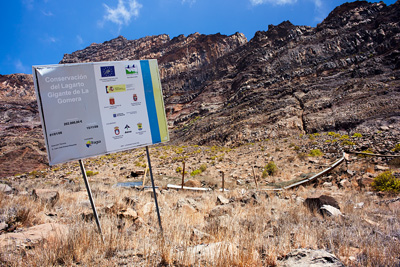
Risco de la Mérica - terra typica and the entire distribution area of Gomera Giant Lizard (Gallotia bravoana). The information board is telling about a conservation project supported by the EU. One of the aims of this project was building a fence in front of the habitat of the lizards. This fence collapsed after the project was finished, and the protection area was looking abandoned when I visited it. (Click on picture to enlarge.)
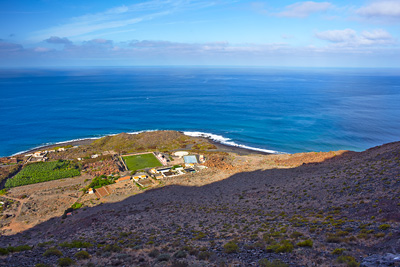
View from the habitat of G. bravoana at Punta de la Calera, Playa del Inglés and “Lagartario” - the breeding station. This photo was taken at 10:25 a.m. As you see, this side of the rock was still entirely in a deep shadow. (Click on picture to enlarge.)
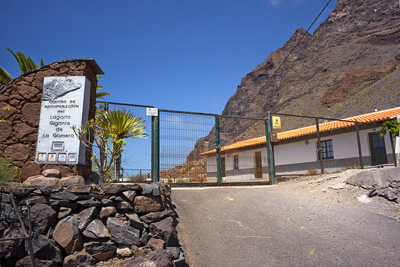
Breeding station of a conservation and reintroduction project for Gomera Giant Lizard (Gallotia bravoana). Just behind it - the habitat of the only existing population of this species. (Click on picture to enlarge.)
I suspect three reasons why I failed to find both most interesting species — the “giant lizards” of La Gomera and of Tenerife. The first and most important reason was the season: It had been an extremely hot and dry summer; very few green plants were remaining. Even in less hot places than rocks I was seeing not so many individuals even of common species. I suppose therefore that the majority of lizards were hiding continuously from the sun or even hibernating. The second reason was the difficulty of the terrain that I underestimated in my planning. When I was seeing those habitats on photographs, of course, I was understanding that G. bravoana and G. intermedia live in a rocky area, but I didn't recognise that to photograph them one would need to literally climb walls. If I knew that I would need it, I would have prepared myself for this. The third reason was my limited knowledge of the places where to search for these lizards. Ideally, there should be a local guide or a consultant. I didn't know myself such an expert and had no time to find one because the decision to go to these region was made quite spontaneously. Therefore, there was nobody during this trip who could help me with exact knowledge of localities where the lizards can be found.
gallotia bravoana
The access to the area with the remaining population of Gomera Giant Lizard (Gallotia bravoana) was relatively unrestricted although this species is listed as critically endangered. This place — Risco de la Mérica (La Mérica Rock) — is right behind Playa del Inglés — a popular beach of Valle Gran Rey. It has a very distinctive pyramidal shape and therefore is easy to find. It is also on any map of La Gomera with a scale of 1:40 000 or less, along with the breeding station of the conservation project “Centro de Recuperacion del Lagarto Gigante de la Gomera” (or “Lagartario”) which is right in front of the rock. The entire area north of Playa del Inglés is officially protected as a nature reserve. The access to it is open to everyone who obeys the usual rules for such conservation areas — “Do not litter”, “Do not disturb wildlife”, “Do not make fire”, etc. — which are also stated on an information board placed at the beach.
As I mentioned above, I stayed in a hotel nearby for 5 days and could reach the rock within a few minutes. I made 3 excursions to it attempting to find the lizards. The wall where the lizards live is looking west. In the morning this slope is cold because it is completely within a shadow of the rock. The sun starts coming out to this side of the rock at 10 a.m., and in this season at noon it is already burning with full power. There was no sense to come earlier than 10:00 a.m. or later than 11:00 a.m., i.e. there was only 1 hour for work — when, according to my estimation, the lizards might be basking and not hiding.
The rock is in reality larger than it appears when you are looking at it from the town. The base of the it is completely covered by debris that you have to pass to reach the the stony wall and to start climbing to the levels where the lizards live. It is very difficult to walk on this field of smaller and larger stones, and I needed about an hour to cross it.
The wall is steep but not really vertical, i.e. anyone in good physical shape should be able to climb at least the lower half of it even without special equipment. The upper half is steeper but also not vertical. Most of it is free of vegetation. Some green plants persist only on ledges that are very easy to recognise even when you are standing at the bottom of the rock. Since adult gallotias of this species are strictly vegetarian these ledges can be the only places on the rock where they come to feed. Therefore it appeared logical to search there.
I reached the lowest of them carrying the backpack with photo equipment. Without this heavy load I could climb even higher. To be able to do get also the equipment on the rock one would need a ropes, nails and hooks. It should be also wise to wear body and head protection (helmet). I had nothing of that stuff. Therefore I stopped climbing when I arrived at the second such ledge and recognised that the slope was getting steeper. Leaving the backpack and climbing without it didn't make much sense because I came to photograph the lizards. To continue without ropes and protection also appeared too dangerous. Therefore I searched the places with green that I had access to. After that I sat down on the highest ledge that I managed to reach and started waiting for the sun to shine at this place. It was 10:30 a.m., but the entire western side of the rock was in a deep shadow. One hour had to pass till the sunshine reached the place where I was sitting. It was quickly getting hot. I started searching again because it looked like the only time when the lizards, if there were any, should come out for feeding.
I searched very carefully all places with green vegetation that I could reach and was also using a binocular to look at the places that were higher. Unfortunately, I discovered neither lizards nor any other animals. The area appeared almost lifeless. Near noon the entire western side of Risco de la Mérica stood in bride sunshine and the stones rapidly got extremely hot. I could not believe that any lizards would stay on surface in these hours. It was also the time when lizards of the common species — G. caesaris — were disappearing, too. Even if G. bravoana don't hibernate in this season, their daily period of activity should be limited to a couple of hours. Since such large lizards need much food and since the green plants are rare in their habitat, it appears to me unlikely that one or two hours would be enough time for finding and eating them. A lizard also needs some time for basking because its body has to reach certain temperature before the animal can feed.
I have no doubts that I was searching in the right place. The ropes that were hanging on the rock and that the researchers were using as climbing aid were another confirmation of this. Since I didn't find even young individuals of this species who probably eat insects, I suppose that the lizards weren't active at all in this hottest period of the year. Since the entire wild population of this species is estimated as 150-200 individuals and since this south-western wall of Risco de la Mérica is the entire distribution area of it, I can't believe that the lizards were there and active but I've just overseen them. Therefore I have two recommendations for someone willing to find the giant lizards on La Gomera and for me if I should decide to go there again. First, the season should be colder — either spring or autumn, or even winter. Second, the search should be tried higher on the rock. Of course, it should make sense to contact an expert — a staff of the breeding station, or someone who conducted a research of this species.
gallotia intermedia
The Tenerife Speckled Lizard (Gallotia intermedia) is the fourth largest extant species in this genus. It was also discovered quite recently — in late 90-s. The terra typica is the rocks Acantilados de Los Gigantes (Cliffs of the Giants) at the south-western coast of Tenerife. With estimated number of 1500-2000, the total population of G. intermedia is much more numerous than of G. bravoana. This species is currently known from two localities — the coastal rocks between Punto de Teno and the town of Los Gigantes, and from the Montaña de Guaza (Guaza Mountain) at the eastern end of Los Cristianos. Since the distribution area of Tenerife Speckled Lizard is quite extended, this species doesn't appear to be in acute danger although it may suffer from predation by stray cats.
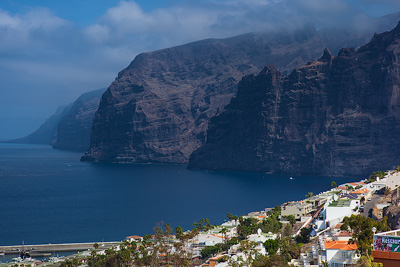
View at Acantilados de Los Gigantes (Cliffs of the Giants) — the terra typica of Tenerife Speckled Lizard (Gallotia intermedia). (Click on picture to enlarge.)
The ecology of G. intermedia appears to be similar to that of G. bravoana: It inhabits dry rocky places with scarse vegetation, at the southern or south-western coast. Unlike G. bravoana that has been found so far only on a very steep slope of a rock, G. intermedia also occurs in a more plain areas — on the Guaza Mountain and at nearby locations.
I searched for my photography subjects in both populations but again had bad luck. In the western population I tried to find the lizards at two sites — near the town of Los Gigantes and at Punto de Teno. Both locations are in the same chain of Los Gigantes rocks, but at the both ends of it. There are no doubts that I was searching in the right places, but like with the Gomera Giant Lizards, I suppose that all living beings were hiding from the heat during this extremely hot summer. Anyway I didn't see adult lizards of any species at all. A couple of young that I finally found and photographed in Baranco Seca — a gorge of a dried river — and that I initially thought were juvenile G. intermedia later turned out to be G. galloti.
The habitat of Tenerife Speckled Lizards at Los Gigantes is very easy to find: It is on the huge cliffs — Acantilados de Los Gigantes — that you see from any point in the town. All I needed to get there was to find a street leading to the cliffs. It was Calle Tabaiba that ends with a small parking lot. A path along the cliffs starts right at it. The entrance to the path was closed with a portable fence, a warning sign was informing that the path shouldn't be used. I supposed that this warning was intended for the inhabitants of the villas nearby — people from Germany and other countries who own holiday apartments there and may want to go to the cliffs for a walk. Indeed, I saw people searching for a way to the cliffs, and also a woman who lived in a villa told that the official recreation path was higher — near the top of the rocks.
I took that lower that was closed. First it was quite broad, and walking was absolutely no problem. At about 200m from its beginning I saw a bronze plate on a rock telling that “Lagarto Canario Moteado” — i.e. Gallotia intermedia — had been first discovered in this place. This was a sign for me that I had determined the location correctly.
This slope was still in shadow, and I didn't hurry. A couple of times I sat down not only to rest but also to wait for the sun. Finally the sun appeared, and its light was quickly getting brighter and hotter. Against my expectation no lizards were appearing: the slope was looking lifeless. Very soon it got very hot. I continued walking and looking for any lizards. Sometimes I left the path and searched in a wider area on both sides: No lizards were around.
Till noon, when the sunshine got really strong and the entire slope was standing in it, I went only a few kilometers in one direction, and there was no sense to go further. The slopes were extremely dry. There was no water and almost no green plants. When I reach a dried river bed I saw a few young gallotias. Since there were no adult individuals of G. galloti around, I thought that they were juvenile G. intermedia, particularly because they were looking not like the juveniles of G.g. eisentrauti that I had seen on the northern coast. I photographed one of those young lizards and went back to the parking lot. On the way the accident happened that I described in the grey box above.
The second known population of the Tenerife Speckled Lizard is in the area around Guaza Mountain (Montaña de Guaza). It is in immediate proximity of Los Cristianos — one of the most popular beach holiday destinations in Tenerife. Los Cristianos itself is probably the least attractive town on the island. It consists almost entirely of giant hotels and international tourist ressorts, and is a typical sun-and-fun holiday place. Therefore, I didn't want to stay long there and reserved only a couple of days at the end of the trip for a search for G. intermedia.
The Guaza Mountain itself and the land around it is officially protected as a nature reserve - Paraje Natural Montaña de Guaza. Nevertheless, the access to it is neither restricted nor regulated. Everyone can just drive closer to it, leave the car somewhere and walk to the mountain.
It is less than 400 m high, looks more like a hill, and is very easy to climb. The slopes aren't steep. It surprised me that the habitat on Guaza Mountain was very different from what I had seen at Los Gigantes. However, just like there, the Tenerife Speckled Lizard was also here sympatric with the Western Canaries Lizard (Gallotia g. galloti). The latter were very common but hard even to see because they were very shy. Of G. intermedia I have seen no signs at all.
The weather was again very hot, and there were almost no green plants around except prickly pears (Opuntia). I am sure that heat was the reason why almost no living beings were active.
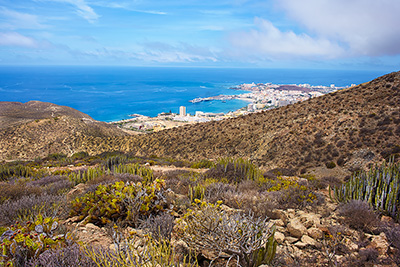
View from Guaza Mountain at the town of Los Cristianos. A natural habitat of Western Canaries Lizard (Gallotia galloti galloti) and also presumably of Tenerife Speckled Lizard (G. intermedia) is in foreground. The G. galloti can be found a many places in Los Crisitanos, however. (Click on picture to enlarge.)
There is a hill adjacent to Guaza Mountain whose western slope ends in the ocean. According to the information that I had gathered, the Tenerife Speckled Lizards are found closer to the coast, i.e. on this hill which can be regarded as belonging to Guaza Mountain in a broad sense. The next day I searched on this hill too but found it empty: There weren't even G. galloti around.
Since Monataña de Guaza is so close to the south airport of Tenerife “Aeropuerto Reina Sofia” where many flights from Europe land and since the harbor of Los Cristianos is connected by ferries with other islands, I am certainly planning to repeat the search in this place during my future travels to Canary Islands.
gallotia galloti
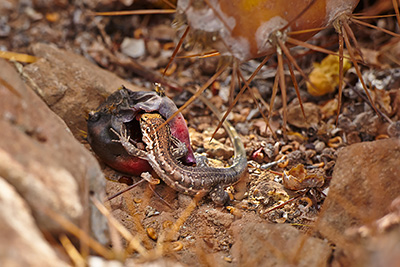
According to my observations, the lizards were feeding mainly on fruits of Opuntia in this extremely dry season. Here you see a juvenile G. g. galloti doing it. (Click on picture to enlarge.)
The Western Canaries Lizards (Gallotia galloti galloti) on mountain Guaza are extremely shy — particularly the adults. Although I was noticing them moving in the dry vegetation, I could rarely see the animals themselves. It appeared to me that the population density in this place was not that great than of G. g. eisentrauti that I observed in the north of the island. Young G. g. galloti have different pattern than young G. g. eisentrauti. To me it appeared similar to the pattern of young Gallotia intermedia that I had seen on photographs. Therefore I thought first that I was seeing G. intermedia. When I saw the adult gallotias which were definitely G. g. galloti, I recognised my mistake.
There are three subspecies of Gallotia galloti on Tenerife. Two — G. g. galloti and G. g. eisentrauti — live on the main island where they are very common. The distribution area of the first covers the south and the far west of Tenerife, while the second lives in the north and the east. The mountains in the middle of the island appear to serve as a barrier between them. The western border is very easy to recognise because the transition from galloti to eisentrauti is very sharp: When you are coming by car from Buenavista del Norte towards Punto de Teno after you passed the tunnel you'll find only lizards of the nominate subspecies. At Buenavista and all the way to the tunnel there are still lizards of the subspecies eisentrauti. The eastern border between subspecies should be caused by Anaga mountains. I personally didn't observe the point where it happens.
A population of the third subspecies — G. g. insulanagae — exist only on a small rock near the coast of the Anaga Peninsula at the eastern end of Tenerife — Roque Fuera de Anaga. I have seen only one image of a male of this subspecies. Therefore I am eager to photograph these lizards myself. Unfortunately it is difficult to organise. The place is very easy to find. You have to come by car to the village Garachico and then to hike to the lighthouse. After you reached the lighthouse you'll see a triangle rock standing in water less than a kilometer away from the coast. That's the Roque Fuera de Anaga.
A real problem is to reach the rock. Although it is a protected area, no special permission is required to visit it as far as I know — but you need a boat. I hadn't any and didn't even try to organise one because local people in this area speak only Spanish, and with my poor command of this language I wasn't able to find a fisherman and to negotiate with him. When I went to this place, I didn't know that the rock is so close, I was only planning to photograph the landscapes of the Anaga Mountains. Now I know that Roque de Fuera is very close to the coast of Tenerife and can be reached by a normal fisherman boat — worth an attempt if would visit this place again.
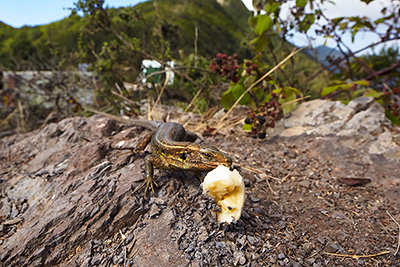
Baiting with small banana pieces works well with all adult gallotias. (Click on picture to enlarge.)
To me Gallotia galloti is the most beautiful species of this genus and eisentrauti is the most beautiful subspecies of it. Males are large and particularly colourful. Also females of G. g. eisentrauti have more clear body pattern and more bright colour than of G. g. galloti. Many males of the nominate subspecies have larger blue areas on their sides but the striped pattern isn't so well recognisable. Adults of both subspecies feed on plants and like sweet fruits, such as banana, peach, strawberries, that can be used as bait, to attract them to a place where you can better photograph them. Of course, even then they remain shy and can be easily scared by sudden movement. However, even when they have run away they return very soon to the fruits.
With much more shy G. g. galloti a more crude method is effective — capturing. Gallotias are very quick and see very well. In the hot season, when I was there, adult G. g. galloti weren't allowing to approach them closer than 6-8 meters. G. g. eisentrauti appeared to me generally less shy. In towns, for instance in Puerto de la Cruz, the lizards were allowing a distance of just 2 meters or even less because they were accustomed to the presence of people who often even fed them. Nonetheless, in most populations that I visited the only way to a macro or a close-up shot of a Gallotia galloti was to catch it. Since the lizards escape in thick thorny vegetation or in rocks before you approach them, you can't do it with hands. I was using a fishing rod with a snare. It worked fine on adult animals.
When gallotias are active their bodies are very warm. Anyway they felt warmer than for instance of sand lizards I often had a chance to hold in hands. The body even of a large adult lizard feels soft — probably due to small scales that cover it. When caught, first it attempts to bite but very quickly stops any resistance and remains motionless as long as your hand is closed. As soon as you loosen the grip just a little the lizard will immediately attempt to escape, and usually will succeed. So you have to be very careful and quick when photographing. It is not like with many other lacertids that would usually stay in place for awhile after you have removed the hand: A gallotia will disappear even before you have noticed it. Therefore, when you are handling a gallotia be prepared for only one shot that you will need to release in a fraction of a second. If you have a quick reaction and if there are no escapes in immediate proximity, you may be able to catch the lizard again with a free hand and return it in position in front of the lens. Even then sooner or later it will run away.
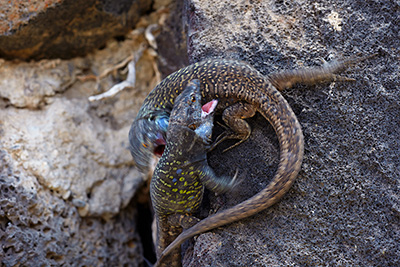
Adult gallotias are strictly territorial — both, males and females. Neigbours who attempt to trespass will be fought and chased by the owner of the territory. During such quarrels the animals usually are squeking loudly. Along with strictly vegetarian diet of adult animals, the ability to vocalisations is probably the most amazing in this lacertid genus. (Click on picture to enlarge.)
When caught and put in position for a close-up photograph G. galloti look depressed for the first second when you are photographing them. However, it doesn't make sense to wait longer: As soon as the animal takes a more natural pose, it escapes. Therefore, it is extremely difficult to obtain a decent wide-angle or macro image of G. galloti. I am not really satisfied with those that I managed to get during this trip and will repeat the attempts as soon as I have another opportunity.
The easiest approach, although not always resulting in artistic images, is shooting with a telephoto lens. At some locations I was using a 150mm macro lens — sometimes with a 2x teleconverter — with quite good results. It proved to be particularly useful for photographs of younger animals of both subspecies and of adult G. g. eisentrauti. For adult G. g. galloti I needed a 300 mm f/2.8 super telephoto lens. Quite often, I had to shoot through vegetation; then the large aperture of this lens was particularly helpful. However, carrying both lenses along with other equipment is difficult and doesn't make much sense. A 2.8/150mm or 2.8/180 mm macro lens in combination with a teleconverter lens is more lightweight and more flexible alternative that I would recommend in this case.
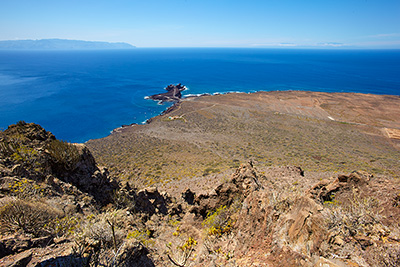
View from Acantilados de Los Gigantes at Teno Cape — habitat of Gallotia galloti galloti. The neighbour island, La Gomera is visible at the horizon. (Click on picture to enlarge.)
The best locations for photographing Western Canaries Lizards in natural habitat I have been to during this trip were Teno Cape (Punto de Teno) and Guaza Mountain (Montaña de Guaza) — for G. g. galloti, and Anaga Peninsula — for G. g. eisentrauti. Of course, the lizards are very numerous and easier to approach in towns and villages, and thus are easier to photograph, but the urban surroundings may be visible in your pictures, particularly if you'll be using wide-angle lenses.
gallotia caesaris
Boetger's Lizards (Gallotia caesaris) are for La Gomera the same as Western Canaries Lizards (Gallotia galloti for Tenerife — the most common and widespread reptile species. The population on this island is of subspecies G. c. gomerae. Someone who doesn't want to go to La Gomera but wants to see or to photograph them can do it on Tenerife where G. c. gomerae occur in the town of Los Cristianos because they are being brought there by ferries. In turn, G. galloti already occur on La Gomera, for the same reason.
Boetеger's Lizards are really omnipresent on this island. You can find them on the coast as well as in the middle. Since La Gomera is small and there are no high mountains, there are no barriers that would isolatе populations, causing evolution of subspecies. You can drive around the island in less than a day and would see everywhere G. caesaris looking the same.
The adult individuals of G. caesaris are much smaller than of G. galloti. Males look a little larger than medium-sized European lacertids — such as sand lizards (Lacerta agilis) — and aren't as colourful as the males of G. galloti.
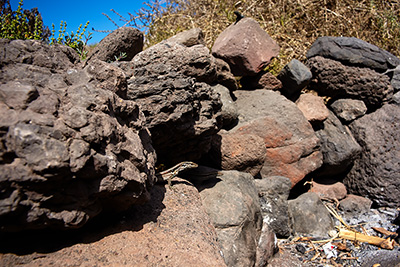
As usually with young lizards, they allow a closer distance than the adults. However, this isn't a big help when you are trying to photograph them with a wide-angle lens: The distance is still too large because the lizards are small. This image shows young G. caesaris gomerae shot with a 25mm lens in their habitat at Playa del Inglés. (Click on picture to enlarge.)
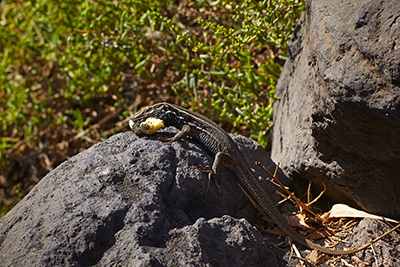
Feeding gallotias was for me not only a method for getting closer but an act of help the animals to survive in this hot season, particularly after their natural food sources were distroyed by fire. (Click on picture to enlarge.)
Overall, G. caesaris on La Gomera appeared to me not as shy as G. galloti on Tenerife. The minimal distance they were allowing was 2-3 meters. Of course, it was too far for photographing with wide-angle lenses, but close enough for good shots at focal distance 150 - 300 mm. For close-up photographs, the lizards needed to be caught. Just like with G. galloti there were no chance to do it with hands, but the method with fishing rod worked with large males very well.
Like other Gallotia species, the adult Boettger's Lizards feed on fruits and green plants. Therefore, they could be attracted by pieces of banana or other sweet fruit put in a place suitable for photography. In hot sommer months there is not only enough food for them but also water. Therefore juicy fruits may be especially attractive also as a source of drinking water. In fact, I was very surprised to see so many G. caesaris active in areas without any obviously eatable vegetation and without water. Different than on Tenerife, there aren't so many prickly pears plants, or maybe no at all, because I haven't seen any. On Tenerife theirs fruits were the only significant source of food for gallotias in this season. Such food was much less available or absent on La Gomera.
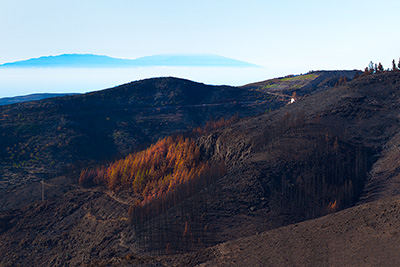
It is hard to show in photographs a real scale of the disaster that stroke La Gomera in 2012. More than a quarter of natural sites turned to ash as a result of the most severe fire in the history of the island. The neighbour island — La Palma — is visible here in the background. (Click on picture to enlarge.)
The summer 2012 will certainly remain in the history of La Gomera because of the most severe forest fire catastrophe this island had ever seen. As a result, more than a quarter of the endemic laurel forest was destroyed. In huge areas of La Gomera nothing remained but ash. I was glad to notice that large numbers of gallotias survived the fire, but at the same time it was heartbreaking to see them desperately searching for food in what was only ash. When I was in such places and had fruit I was giving them and some water to gallotias, but, of course, I wasn't able to feed all of them who suffered the fire.
For photographing G. caesaris gomerae I recommend to bring a lens with focal length of 150-300 mm. This can be a macro or a telephoto lens. If it would be a 150-180mm macro lens, you would need to use it with a teleconverter now and then. For telephoto lenses you may occasionally need macro extension rings — to make the work distance shorter. I also recommend to have a tripod and a lot of patience — to be able to sit and wait till the lizards appear from their sleeping places in stone heaps.
Boettger's Lizards can be found absolutely everywhere on the island where there are places for them to bask. In the central areas that are covered by forest, they live at road sides, near stone heaps, or at rocks. I was photographing them in such locations and in the shrubs that grow near Playa del Inglés at the foot of Risco de La Mérica — the distribution area of G. bravoana.
In the summer the sunshine is very bright. Since G. caesaris have dark colouring, and the males are almost black, they need to be photographed only in the early morning hours when the shadows aren't too deep. The best approach is to notice where a colony of G. caesaris lives and to come the next morning to this place before the lizards appear, to set up the camera on a tripod and to wait. In later hours a flash may help to lighten up the shadows.
photographing landscapes
Another goal of this project is to create quality photographs of “Gallotia's world” — of the landscapes and flora of the places where these lizards live.
The weather wasn't good at all for landscape photography: All days were hot and sunny, with cloudless skies. Unfortunately the above mentioned forest fires happened just a few weeks before the start of my trip, so I couldn't change any of my plans. However, during my photographic excursions on Tenerife and La Gomera I was glad to find out that affected nature sites weren't actually in the areas of my interest and that this catastrophe wasn't disturbing me too much. The places I visited on both islands, but particularly on Tenerife, were still offering many great opportunities for landscape photography.
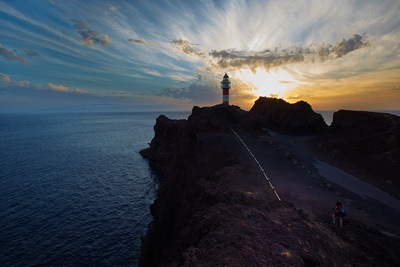
The westmost point of Tenerife - Punto de Teno - is a place that is absolutely worth a visit. (Click on picture to enlarge.)
The following places I liked the most:
- Anaga Mountains and coastal area of the Anaga Peninsula in the east of Tenerife.
- Teno Cape (Punto de Teno) on Tenerife.
- Cliffs of the Giants (Acantilados de los Gigantes) at the south-western coast of Tenerife.
- Relict laurel forest in the mountains of La Gomera.
On Tenerife the best locations for landscape photography are in the east, west and north. The southern coast is arid — a desert with spurges Opuntia cacti. In the best places the vegetation is similar to that of Punto de Teno that has a much more beautiful relief however. It makes much more sense for a landscape photographer to stay in the north of Tenerife (for instance, in Puerto de la Cruz) and to visit the west and the east from there.
La Gomera has a reputation of a beautiful nature paradise. However, it didn't impress me at all. The whole island is covered by stony mountains with coniferous and laurel forest. It was hard for me to find places with more or less nice views, suitable for a good landscape shot.
final remarks
Be prepared to speak some Spanish because you'll meet very few local people with good English or other foreign language.
If you are there in a hot season, find a possibility to carry enough water — around 0.5 litres per hour. A good method is, for example, to have a backpack with a hydration bladder for 3l — an amount of water that should be enough for 6 hours of work. Of course, this would mean carrying additional 3kg, but this weight will decrease gradually when you will be drinking.
Make a trip in late winter, spring or early summer. March to June should be a perfect time.
